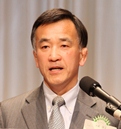One Year After the Great East Japan Earthquake --- What Supports Japan and What is Needed? ---
April 11, 2012
Mr. Yoshifumi Hibako
Ex-Chief of Staff, JGSDF
 The Great East Japan Earthquake was the largest national crisis in the postwar years, inflicting widespread and tremendous damages beyond imagination. The foundation of our lives, including the infrastructure, was lost in an instance. Tsunami damages had more serious consequences than damages by the earthquake itself, a new situation in which the Self-Defense Forces (SDF) had to operate. Our search operations were made extremely difficult and some municipalities could not function.
The Great East Japan Earthquake was the largest national crisis in the postwar years, inflicting widespread and tremendous damages beyond imagination. The foundation of our lives, including the infrastructure, was lost in an instance. Tsunami damages had more serious consequences than damages by the earthquake itself, a new situation in which the Self-Defense Forces (SDF) had to operate. Our search operations were made extremely difficult and some municipalities could not function.
<Two-front operation in complex situation>
The SDF was obliged to take a two-front operation in the complex situation of the earthquake, tsunami and nuclear disasters. It was a challenging and unique operation, as we had to search for the missing and guide the evacuees in radioactively-contaminated areas.
��Challenges implemented by the SDF
<The largest mobilization over an extensive period>
Right after the Earthquake, I gave an immediate order to dispatch troops to the disaster areas and within a week, as many as 100,000 land, sea, and air force personnel were mobilized in the Tohoku area.
The Order for Large-scale Disaster Dispatch was issued on March 11th, and ended on September 9th, while the Order for Nuclear Disaster Dispatch issued on March 11thcontinued until December 26th.
<Five simultaneous operations conducted by the first Joint Task Force>
The Joint Task Force (JTF) comprising the land, sea, and air forces was established on March 14th and implemented the following 5 operations simultaneously, under the command of Eiji Kimizuka, then Commander of the Headquarters for the Tohoku region:
1) Search and rescue
We conducted search and rescue operations under an extremely difficult situation, in areas with devastating damages to the infrastructure. Massive amount of rubbles, flooded areas, submerged lands and collapsed houses hampered our operations. 27,000 people were rescued, 19,000 of them by the SDF. Unfortunately, 9,505 were found dead.
2) Daily life assistance to the Earthquake victims
Water and food supply were in dire need at the evacuation centers. We found out that damaged gas stations suspended the smooth delivery of relief supplies. SDF thus formulated a nation-wide logistics system, which I believe improved the situation dramatically. Our comprehensive operation included food and water supply, medical support, bathing assistance and epidemic prevention.
3) Emergency rehabilitation and road clearing
SDF worked in collaboration with private entities for emergency rehabilitation, ranging from removal of massive rubbles, clearing land for temporary housing and securing the burial grounds.
All the roads that had run along the coast were damaged and the SDF cleared the roads that totaled 400 kilometers in length and built bridges.
4) Activities to stabilize nuclear power stations and assisting the evacuees
Our initial operation focused on assisting the Tokyo Electric Power Company that included transportation of the power supply vehicles and the 5-ton water supply trucks.
Hydrogen explosions at the nuclear reactors worsened the situation drastically and we finally came to realize the scope of danger when our personnel got injured.
We dumped water for cooling from helicopters on March 17th. This was indeed a demanding decision to make, as nobody could assess the real situation of the nuclear reactors.
Water discharge operations from helicopters were followed by injecting water from fire trucks. SDF also provided assistance and care to residents within the evacuated areas. Search operations and removal of rubbles started on April 18th.
5) The first full-scale Japan-US joint initiative
The US initially deployed an aircraft carrier and marine forces. Joint Support Force (JSF) or the so-called ��Operation TOMODACHI�� deepened alliance between the two countries, especially developed closer relations between the US forces and SDF.
<Lessons for the nation>
There are growing risks of earthquakes directly below Tokyo or the Nankai megathrust. We must learn lessons from the 3.11 Earthquake and prepare for possible future risks.
107,000 SDF personnel were dispatched to the disaster areas and engaged in demanding operations. We were credited for our all-out operation, yet I have to emphasize that we were almost overstretched in such a scale of disaster. The Earthquake raised serious questions about the adequacy of national defenses. We must urgently improve the inter-active services of the Central Disaster Prevention Council, the Security Council of Japan as well as related ministries and agencies.
A mutually complementary framework is also needed that will give assistance by the central government or among local governments to municipalities that cease to function.
<Lessons for SDF>
SDF must be further reinforced, through enhanced joint operations. On a governmental level, the Japan-US alliance should be fortified that will facilitate assistance by the US in case of emergencies.
<Protecting our country by ourselves>
I sincerely hope the SDF relief operations for the 3.11 Earthquake will raise a question about the future defense system of Japan and roles to be played by SDF.
The Japanese people must become self-reliant first, then comes mutual aid and finally public help. You cannot expect much from your country in the initial phase. The rule must be ��protecting our own lives by ourselves.�� It is equally important to network among neighbors to help each other. It is for sure, however, that you cannot save people��s lives unless nation-wide measures are taken.